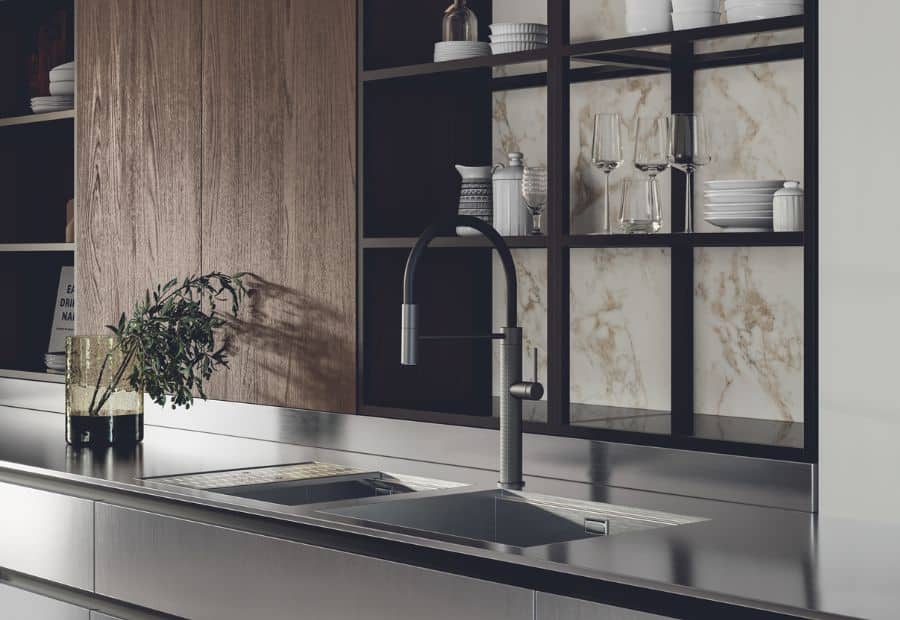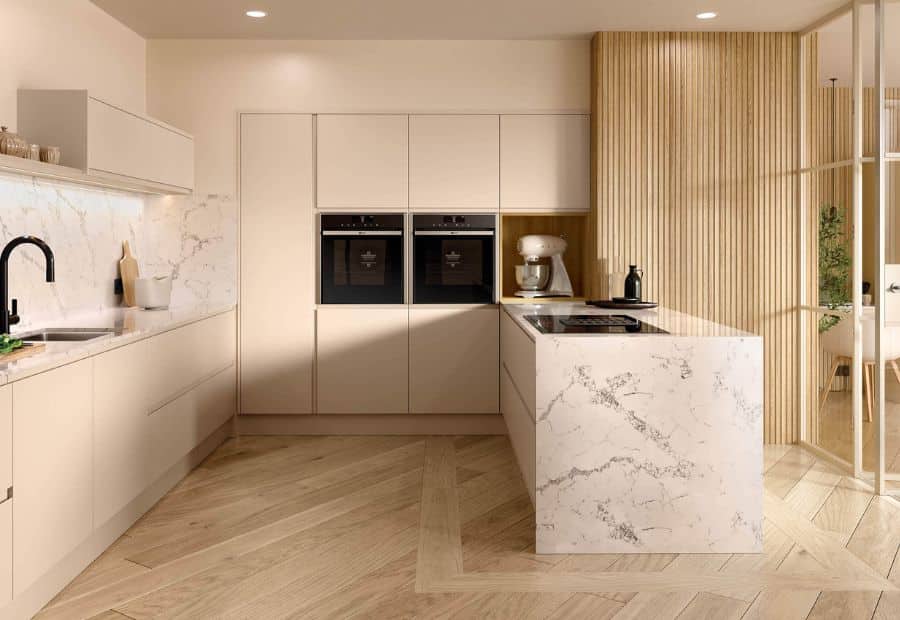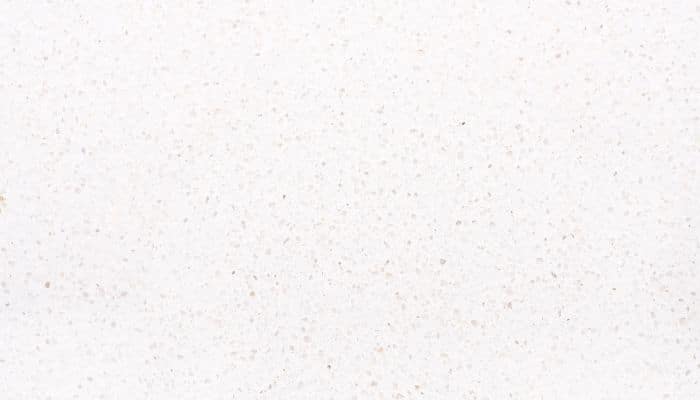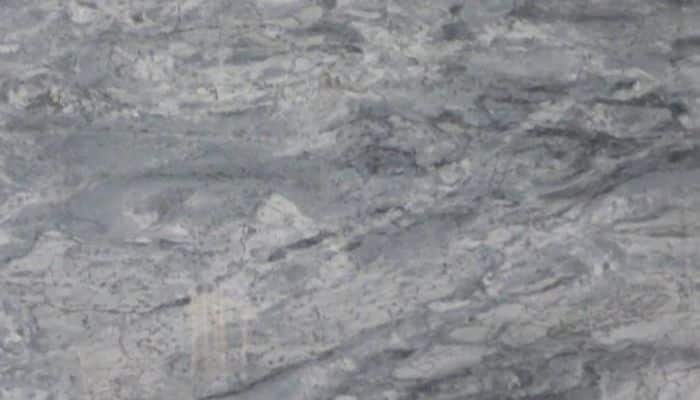Choosing the perfect kitchen worktop is one of the most important decisions in designing a functional and stylish kitchen.
Worktops not only need to be practical and durable but should also complement the overall aesthetic of your kitchen.
In this comprehensive guide, we delve into everything you need to know about kitchen worktops, from materials and maintenance to budget considerations, helping you make an informed decision for your space.

Choosing Your Kitchen Worktop
When it comes to designing your kitchen, one of the most important decisions you’ll make is choosing the right worktop. Not only does it set the tone for the entire space, but it also plays a key role in your daily kitchen tasks. Given the substantial investment in your kitchen and appliances, Your worktop choice should be given plenty of thought and consideration. After all, it will likely be a central part of your home for many years to come.
As much as we’d all love to splurge on high-end materials, your budget will almost always be a major factor in the decision-making process. But don’t worry there are plenty of affordable options that are both stylish and functional. The key is finding a balance between cost, durability, and your specific needs.

The first step in choosing the perfect kitchen worktop is to think about how your space will be used. How many people will be using the kitchen? How often will it be in use? If your kitchen is a busy hub—whether for cooking large family meals, entertaining friends, or handling everyday tasks—you’ll need a durable worktop that can withstand regular use.
Choosing a Worktop for High-Use Kitchens
If your kitchen sees a lot of action, durability should be a top priority. Natural stone options like granite and engineered stone surfaces such as quartz are excellent choices because they can withstand heat, sharp objects, and frequent cleaning. While these materials may have a higher upfront cost, their long-lasting performance makes them a worthwhile investment for high-traffic kitchens.
Choosing a Worktop for Minimal Use
For kitchens with lighter use, there’s more flexibility in selecting a budget-friendly material. Laminate, for example, is a practical option if the space won’t endure heavy daily use. It comes in a variety of designs, is easy to maintain, and is a great choice for those seeking a functional yet affordable worktop.
Types of Kitchen Worktops
Choosing the right kitchen worktop material is essential for functionality, durability, and aesthetics. There are various options available, each offering unique advantages and considerations.
Quartz Worktops
Quartz worktops are highly durable, non-porous, and require minimal maintenance. They come in a variety of colors and patterns, making them a versatile choice for modern kitchens. However, they are not completely heat-resistant and require professional installation.
Granite Worktops
Granite worktops are known for their natural beauty and durability. They are heat-resistant and scratch-resistant, making them ideal for high-use environments. However, they require periodic sealing to maintain their integrity and can be heavy, necessitating professional installation.
Marble Worktops
Marble worktops exude luxury with their unique veining and naturally cool surface, making them perfect for baking enthusiasts. However, they are prone to staining and scratching, requiring regular maintenance and sealing.
Sintered Stone Worktops
Sintered stone worktops are an ultra-durable option that resists heat, stains, and UV exposure, making them suitable for both indoor and outdoor use. While they offer superior performance, they can be brittle under impact and must be installed by professionals.
Stainless Steels
Stainless steel worktops are favoured in professional kitchens for their hygienic, non-porous surface and heat resistance. While easy to clean, they are prone to scratches and fingerprints, and their industrial aesthetic may not suit all kitchen styles.
Wood and Butcher Block Worktops
Wood and butcher block worktops bring warmth and natural appeal to a kitchen. They can be sanded and refinished over time, making them a sustainable choice. However, they require regular oiling and are susceptible to water damage if not properly maintained.
Laminate Worktops
Laminate worktops offer an affordable and stylish option, with a wide range of designs that mimic natural materials. They are easy to maintain and install but are less durable than stone and can be damaged by heat and sharp objects.
Concrete Worktops
Concrete worktops provide a modern, industrial aesthetic and can be customised to suit individual preferences. While durable, they require sealing to prevent stains and may develop cracks over time.
Durability Considerations
A kitchen worktop needs to handle daily wear and tear—from meal prep and chopping to supporting heavy cookware and resisting spills. Quartz, granite, and sintered stone are among the most durable options.
Quartz is highly resistant to scratches, stains, and chipping, while granite’s natural heat resistance makes it ideal for placing hot cookware directly on the surface. Sintered stone, manufactured through advanced technology, offers exceptional durability against heat, impact, and scratches.

Your choice of material should align with your kitchen habits. If you often place hot pans directly on the worktop, granite and sintered stone (such as Neolith, Dekton, and X Stone) are excellent for their ability to resist thermal shock. If spills are a concern, non-porous quartz prevents liquid absorption, reducing the risk of stains and mould.
Additionally, opting for rounded or beveled edges can help minimise chipping, making the worktop safer for households with children.
Moisture resistance is another crucial factor, particularly around sinks and dishwashers. Wooden worktops require regular sealing to prevent water damage, while materials like stainless steel and quartz are naturally water-resistant, maintaining their integrity in damp environments. Unlike marble, which can discolour over time, engineered surfaces like quartz and sintered stone can withstand exposure to cleaning agents and chemicals without damage.
Comparison of Worktop Durability
| Material | Scratch Resistance | Heat Resistance | Water Resistance | Maintenance Level |
| Quartz | High | Moderate | High | Low |
| Granite | High | High | Moderate | Moderate |
| Marble | Medium | Low | Low | High |
| Sintered Stone | Very High | Very High | Very High | Low |
| Stainless Steel | High | High | High | Medium |
| Wood | Low | Low | Low | High |
| Laminate | Medium | Low | Medium | Low |
Maintenance
The maintenance needs of different worktop materials vary significantly and can impact both their appearance and lifespan. Choosing a surface that suits your lifestyle and the amount of time you’re willing to dedicate to upkeep is essential for keeping your worktop looking its best for years to come.

Maintenance Comparison:
| Material | Maintenance Level | Key Tips |
| Quartz/Quartzite | Low | Wipe with a soft cloth and mild soap; no sealing needed. |
| Granite | Moderate | Reseal periodically; avoid acidic cleaners. |
| Marble | High | Seal every 6-12 months; clean spills promptly as highly porous |
| Wood | High | Requires oiling; water marks, fading |
| Sintered Stone | Low | Simple cleaning; avoid abrasive products. |
| Stainless Steel | Medium | Can Scratch, water marks, may show fingerprints. |
Edition Maintenance Tips:
- Use Cutting Boards and Trivets: Prevent scratches and heat damage by using protective tools.
- Quick Spill Clean-Up: Especially for porous materials like marble and wood.
- Regular Sealing: Ensure materials like granite, marble, and wood are sealed to enhance durability.
- Avoid Harsh Cleaners: Stick to pH-neutral products to avoid damage.
- Daily Routine: For low-maintenance options like quartz, a quick daily wipe keeps the surface looking new
Practicality
When choosing a kitchen worktop, practicality should align with your lifestyle. Look for materials that balance aesthetics with functionality and resilience.
Key Practicality Factors for Worktops
- Ease of Cleaning: Non-porous materials like quartz and stainless steel are easy to clean with a soft cloth and mild detergent, making them perfect for busy households. Avoid materials like marble if stain removal feels like a chore.
- Heat Resistance: For frequent handling of hot pans, granite and sintered stone are ideal as they resist high temperatures without warping or discolouration.
- Scratch Resistance: If your kitchen sees heavy use, materials like quartz or sintered stone withstand sharp tools and heavy cookware without showing wear.
- Hygiene: In homes with children or a focus on food safety, non-porous materials like quartz and stainless steel prevent bacterial growth with their seamless, impervious surfaces.
Budget
The cost of kitchen worktops varies greatly depending on the material, brand, and quality. Here’s a breakdown:
| Price Range | Material Examples | Notes |
| High-End Options | Marble, Quartzite,Sintered Stone | Luxurious and durable; ideal for premium kitchens. |
| Mid-Range Options | Engineered Quartz, | Balances durability, aesthetics, and affordability. |
| Affordable Choices | Laminate, | Cost-effective; laminate offers style on a budget. |
Factors Affecting Cost of Countertops
- Installation Fees: Professional installation may be required.
- Sealing & Maintenance: Some materials have long-term care costs.
- Customization: Edges, thickness, and finishes impact final pricing.
- Long-Term Value: While high-end materials may cost more initially, they often offer better durability and timeless appeal, reducing the need for replacements.
Worktop Style Guide
Your worktop should complement your kitchen’s overall design. Matching materials to your desired aesthetic creates a cohesive and visually appealing space:
| Style | Recommended Materials | Design Notes |
| Modern Kitchens | Stainless Steel, Quartz, Sintered Stone | Sleek and minimalist; consider neutral tones. |
| Classical/Rustic | Wooden Worktops, Granite, Marble, Quartzite | Adds warmth and texture; ideal for classic designs. |
| Industrial | Concrete, Sintered Stone | Bold and edgy; pair with exposed hardware. |
Neutral tones like white, grey, and beige are versatile and timeless. For a standout look, choose bold veining or patterns in granite and quartz. Mixing materials such as pairing wood with stone islands – adds depth and customisation. For compact kitchens, lighter tones can create a more spacious feel.
Worktop Comparison
Your worktop should complement your kitchen’s overall design. Matching materials to your desired aesthetic creates a cohesive and visually appealing space.
| Feature | Quartz | Granite | Marble/Quartzite | Sintered Stone | Stainless Steel | Wood |
| Durability | ⭐⭐⭐⭐ | ⭐⭐⭐⭐⭐ | ⭐⭐ | ⭐⭐⭐⭐⭐ | ⭐⭐⭐⭐ | ⭐⭐⭐ |
| Maintenance | Low | Needs periodic resealing | High, requires sealing | Low | Low, shows marks | High, regular oiling |
| Heat Resistance | Moderate | High | Low | High | High | Low |
| Cost | €€€ | €€€€ | €€€€€ | €€€€ | €€€ | €€ |
Worktop Colour & Finish Tips
- Neutral tones (white, grey, beige): Timeless & versatile.
- Bold veining: Adds a statement look (ideal in quartz or marble).
- Mixed materials: Combining wood & stone creates depth and contrast.
- Light colours: Great for small kitchens to enhance space perception.
Conclusion
Choosing the right kitchen worktop involves balancing durability, maintenance, practicality, budget, and design. Whether you opt for the versatility of quartz, the natural beauty of granite, or the luxurious appeal of marble, each material offers unique benefits. We can help you evaluate your needs and preferences to select a worktop that enhances your kitchen’s functionality and style.
Visit our showroom in Dungarvan, Co. Waterford, and let us help you find the perfect worktop to suit your style and needs. Book your free, no-obligation design consultation and take the first step toward your dream kitchen!